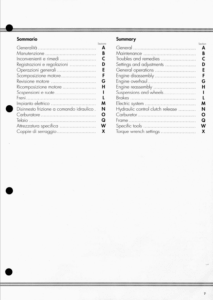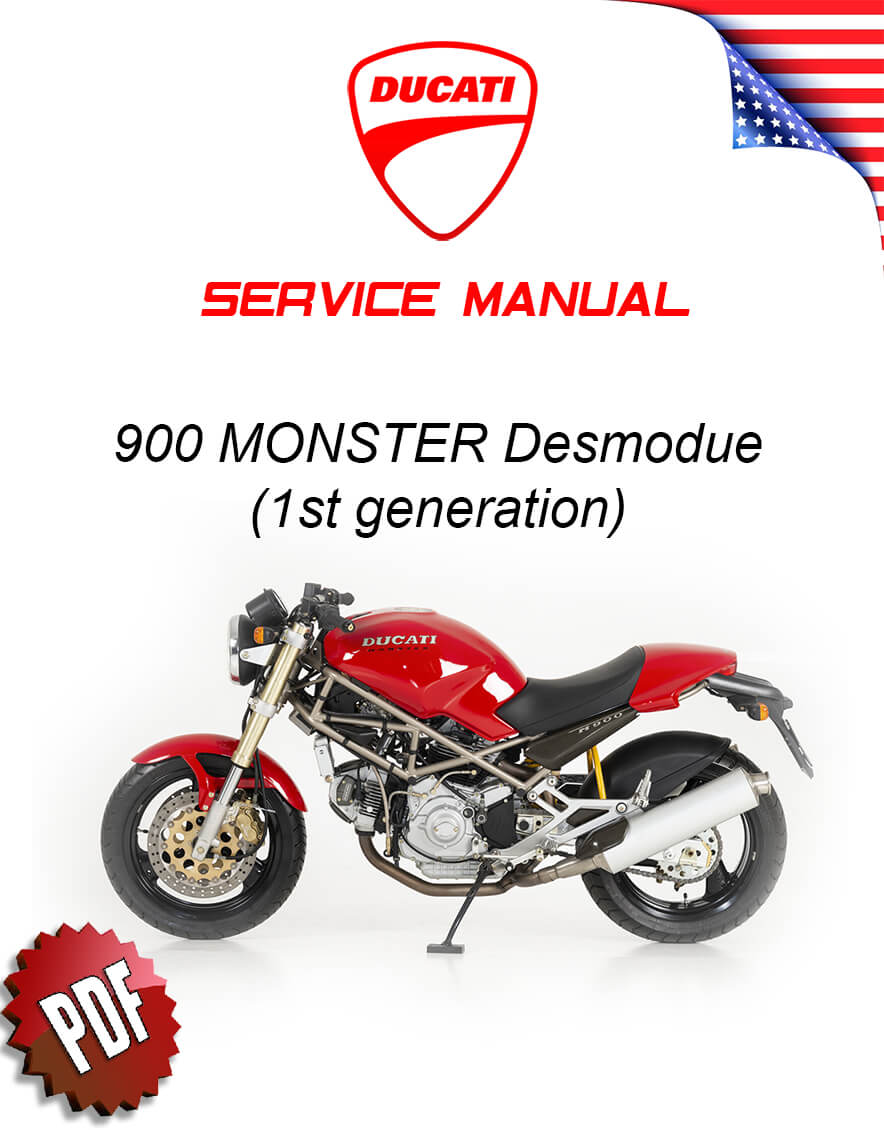Complete PDF version of the Service Manual for the Ducati Monster. A MUST for every M900 owner.
Download: Immediately after payment!
OEM Original factory workshop manual.
Models covered by this manual: 1993-1998 (carbureted)
Number of pages: 271 pages
Table of contents:

This PDF repair manual can be downloaded right after the payment process in complete, on the device of your choice.
We do not offer printed manuals, for the following reasons:
- it is more eco-friendly to use a digital version
- your manual never gets dirty or greasy
- you can always choose to print the specific page(s) you need to work on your bike
- you receive your manual immediately after payment
- it is searchable
Ducati M900
The Ducati Monster (also known as the Il Mostro in Italian) is a standard or naked bike motorcycle developed by Miguel Angel Galluzzi and manufactured by Ducati in Bologna, Italy, since 1993. Monster sales accounted for more than half of Ducati’s global sales in 2005. It sports a 90° V-twin engine, known as an L-twin by Ducati, with desmodromic valves, and a tubular steel trellis frame developed by Fabio Taglioni (1920–2001).
Over the years, the Monster line has seen several modifications, ranging from entry-level 400 cc (24 cu in) bikes to top-of-the-line 160 horsepower (120 kW) multivalve, water-cooled superbike-engined models, with as many as nine different Monster versions in a single model year. The Monster’s essential simplicity has also made it a popular platform for custom motorcycle builders, as shown at events such as the Monster Challenge. Monsters eventually accounted for more than two-thirds of Ducati’s output.
In December 2016, the British weekly newspaper Motorcycle News stated, “The Monster has gone down in folklore as ‘the bike that saved Ducati’ due to its popularity and low development costs,” adding that approximately 300,000 were produced.
Conception and design
In 1992, the Monster was created as a style exercise. Galluzzi had been thinking about the Monster concept for a long time, and it required some convincing to convince the executives at Cagiva and Ducati to create it. Massimo Bordi, Ducati’s technical director, came up with the concept for the new bike and tasked Galluzzi with designing it. Bordi stated that he inquired of Galluzzi “for something with a strong Ducati pedigree but that was comfortable to ride and wasn’t a sports bike He made a suggestion, and I immediately thought, “This is the bike Marlon Brando would be riding today in the film The Wild One!””
Bordi’s intention was to join the cruiser market with a bike designed to be customized and ultimately have a plethora of bolt-on aftermarket accessories rivaling the selection of custom and hot-rod components available for Harley-Davidsons. Cagiva had already attempted to enter this market with a cruiser, the Ducati Indiana of 1986–1990. According to some reports, it made poor use of Ducati’s desmodromic valve V-twin engines and used a full-cradle frame rather of Ducati’s trademark trellis, which played against Ducati’s artistic strengths. Over a four-year period, just 2,138 were produced. The Monster appealed to the same urban, style-conscious clients looking for a bike that could make an individuality statement, but it did so with a machine that was unlike anything they had seen before, while remaining undeniably Italian and a Ducati.
Because Bordi wanted Galluzzi to keep costs low, the Monster was a humble “parts bin special,” built not with newly designed components carefully engineered to work in unison, but by mixing and matching parts from existing Ducati models, beginning with the engine and fork of a 900 Supersport, a frame descended from the 851 superbike, and a fork descended from the 750 Supersport. Galluzzi designed a “muscular” fuel tank and minimalist bodywork to give the sense of heft and strength on a motorbike that proved to be unexpectedly small and nimble to first-time riders.
1990s
In its initial generation, Ducati launched three Monster models: the M600, M750, and M900 (the numbers denote engine sizes). The first M900 was delivered in 1993, followed by the M600 in 1994, and lastly the M750 in 1996. With the launching of the M600 Dark in 1998, Ducati introduced its Monster Dark family of bikes. In 1999, Ducati launched various limited edition Monsters, several with varying degrees of extras, the most prominent being the Monster City, which came in a distinctive blue color and with leather briefcase type saddlebags and taller handlebars.
Since 1994, a lesser displacement variant, the M400, has been produced for various regions where the tax or license system is especially severe on higher capacity or more powerful bikes. The M400 was designed primarily for Italy, Japan, and Singapore, but it was also shipped to Indonesia, the Philippines, Taiwan, and Thailand. The M400 was built on the same basic engine components as the M600, but with a shorter stroke crankshaft and smaller diameter pistons.
Source: Wikipedia


